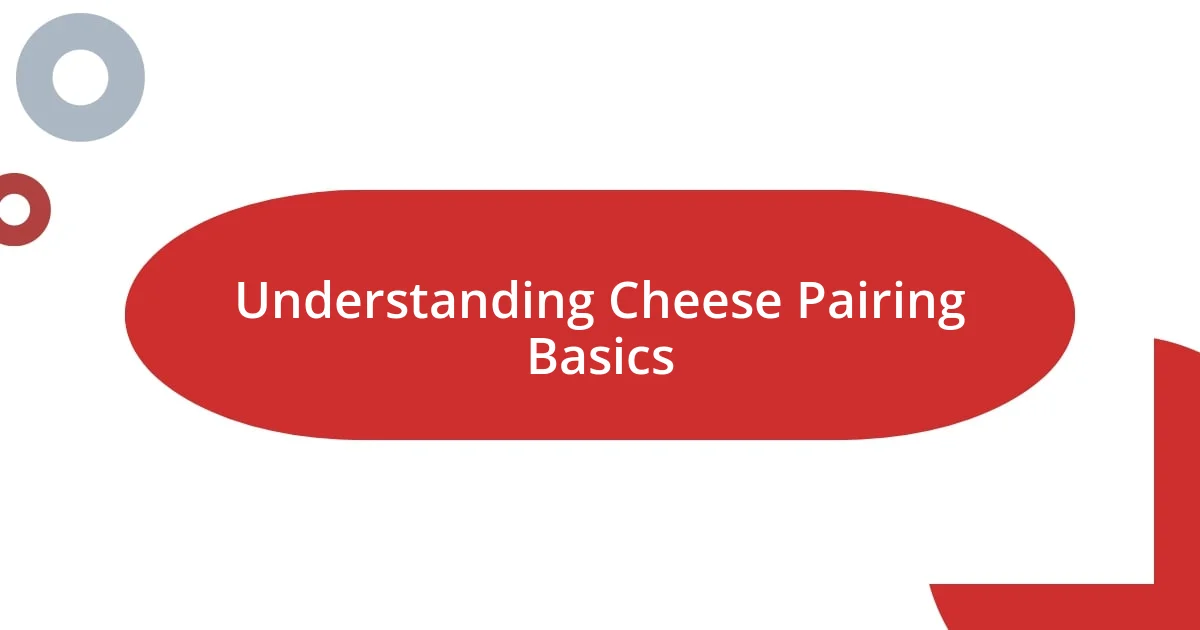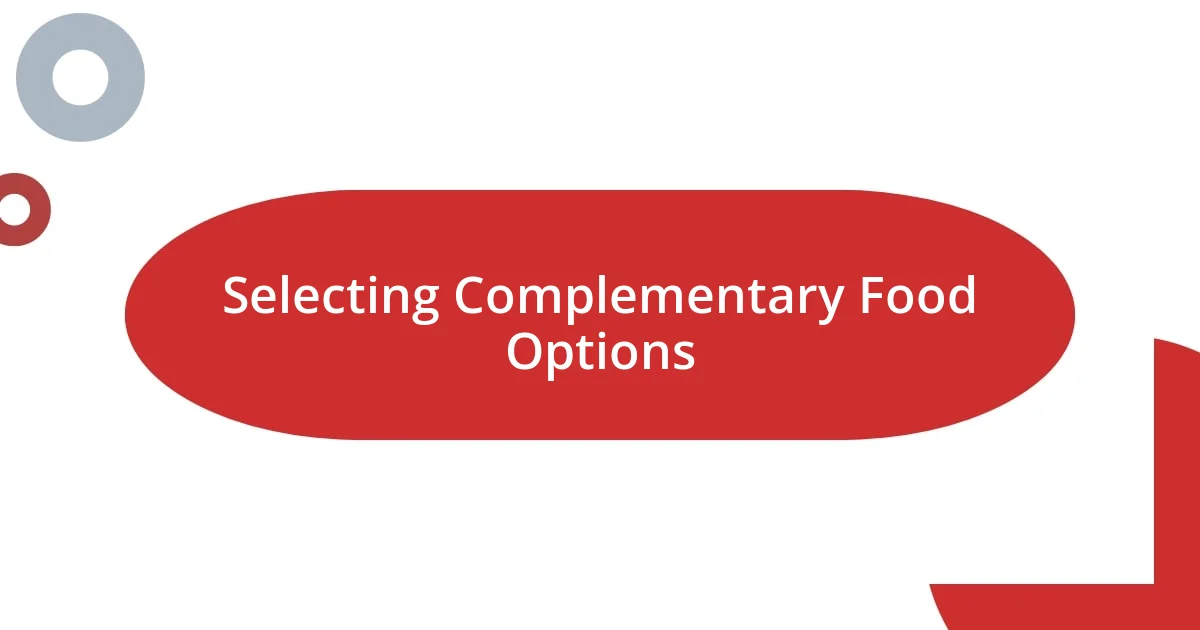Key takeaways:
- Balancing texture and flavor is crucial in cheese pairing, enhancing the overall tasting experience.
- Exploring various cheese types and their unique characteristics fosters joy and community in tasting sessions.
- Documenting pairing experiences through notes and photos enriches future explorations and informs better choices.

Understanding Cheese Pairing Basics
When it comes to cheese pairing, understanding the basics can really enhance your tasting experience. I remember the first time I paired a creamy Brie with a fruity fig jam; it was like a light bulb moment! The rich texture of the cheese met the sweet notes of the jam in a way that was simply divine, prompting me to wonder how many other combinations might unleash such delightful flavors.
One fundamental principle in cheese pairing is balancing texture and flavor. For instance, a sharp, crumbly Cheddar can be beautifully complemented by a smooth and rich Riesling. Thinking back to that day at a friend’s wine and cheese party, I realized how that contrast not only made the flavors pop but also created a memorable experience where everyone engaged in delicious exploration.
Another key consideration is the intensity of flavors. As I’ve often found out, a mild cheese like goat cheese can get lost alongside bold components. I once mistakenly paired a delicate Chèvre with a spicy pepper jelly, which overshadowed its soft creaminess. This taught me that sometimes, less is more. How do you choose the right partners for your cheeses? It’s all about experimenting and trusting your palate.

Exploring Different Cheese Types
Exploring different types of cheese is like embarking on a flavorful adventure. I’ve always been fascinated by how each cheese can evoke different emotions and memories. For example, the first time I tasted a pungent blue cheese, its strong flavor sparked a debate among my friends. Some were fans, while others wrinkled their noses. That experience made me realize how cheese can be polarizing, yet so wonderfully stimulating for our taste buds.
As I continued my journey through various cheese types, I discovered the joy of pairing aged Gouda with toasted nuts. I recall attending a rustic dinner party where the host had expertly shared this combination. The nuts’ crunch balanced the creamy richness of the Gouda perfectly. I felt a sense of delight as I watched everyone around the table get excited about the different textures and flavors. It’s fascinating how one pairing can bring people together, igniting conversations and laughter—a true celebration of cheese.
Different regions and methods of production also influence cheese characteristics enormously. For instance, I once visited a local cheese farm and tasted fresh mozzarella made from buffalo milk. The light, milky texture was so different from the crumbly varieties I was used to. This experience opened my eyes to the importance of trying cheeses from various sources, as they each hold a unique personality waiting to be uncovered.
| Cheese Type | Description |
|---|---|
| Brie | Creamy texture, slightly tangy flavor |
| Cheddar | Sharp, crumbly, and robust |
| Goat Cheese | Soft and tangy, often used on salads |
| Blue Cheese | Pungent with a strong flavor profile |
| Aged Gouda | Rich and caramel-like with a firm texture |

Identifying Flavor Profiles in Cheese
Identifying flavor profiles in cheese opens up a whole new world of tasting experiences. I still remember the first time a cheesemonger guided me through a tasting flight. Each cheese was carefully selected to highlight different flavor notes—from nutty to milky to earthy. I was surprised by how even the tiniest variations could transform the entire experience. The process helped me discern flavors that I previously wouldn’t have noticed, such as the subtle hints of grassiness in fresh cheeses that mimic their diets.
To better recognize flavor profiles, consider these aspects:
- Texture: Reflects mouthfeel; creaminess can enhance or conflict with flavors.
- Age: Mature cheeses often have bolder flavors compared to their younger counterparts.
- Acidity: Provides a refreshing contrast; a creamy cheese could benefit from a tangy element.
- Rind: Different rinds can contribute unique earthy or sweet flavors.
- Milk Type: Cow, goat, sheep, or buffalo—each brings its own character and complexity.
For instance, I vividly recall pairing a nutty Comté with a light, citrusy white wine during a picnic. The way the wine’s acidity cut through the cheese’s richness is a memory etched in my mind. Finding these layers of flavor is not just about the cheese itself—it’s an exploration of balance and harmony that resonates with our palates. Engaging with different flavor profiles has not only educated me but has also made my cheese experiences infinitely richer.

Selecting Complementary Food Options
Selecting complementary food options is an art that can elevate your cheese experience to new heights. I remember a delightful evening where I tried pairing brie with raspberry preserves. The way the creamy, slightly tangy brie hugged the tart sweetness of the fresh berries was nothing short of a revelation. Have you ever noticed how some flavors just seem to “click”? That combination left an indelible mark on my palate, making me eager to experiment further.
When I think about balance, I often find myself returning to the classic combination of blue cheese with honey. This pairing may seem unconventional at first, but the salty, pungent notes of the cheese are wonderfully softened by the sweetness of the honey. I can still picture my first encounter with this duo at a charming wine bar. The bartender, with a knowing smile, served it as a dessert option. What a surprise! That moment taught me the value of breaking away from traditional pairings and embracing unexpected options.
Don’t overlook the impact of contrasting and complementary textures, either. I recall a delightful cheese board featuring sharp cheddar and crunchy apple slices. The crispness of the apples contrasted beautifully with the rich, crumbly cheddar, creating a delightful crunch that made every bite enjoyable. Isn’t it fascinating how texture can play such a crucial role in our tasting experiences? I now make a point to incorporate varying textures in my cheese selections, as it not only excites the palate but also keeps the experience engaging and multifaceted.

Experimenting with Wine Pairings
Experimenting with wine pairings was a thrilling journey for me. I remember my first foray into this world—opening a bottle of Pinot Noir with a creamy Camembert. The velvety texture of the wine wrapped around that cheese so perfectly that it felt like a warm embrace. How could something so simple turn into such a delightful celebration on my palate?
As I dove deeper, I began to explore the intricacies of tannins and acidity in wines. I discovered that a bright Sauvignon Blanc could elevate fresh goat cheese in ways I never imagined. The tanginess of the cheese danced with the wine’s crisp notes, creating a refreshing experience that made me smile. Isn’t it incredible how a single sip can unlock new layers of flavor and transform the mundane into something extraordinary?
I also had a memorable experience with a robust red blend and aged gouda. The wine’s boldness complemented the cheese’s caramelized flavors flawlessly. I realized that the richness of mature cheeses often pairs beautifully with wines that have a bit of character. It sparked a newfound excitement in me—how could I not explore more? Every pairing felt like a story waiting to be told, combining elements of taste and texture into delicious narratives.

Documenting Your Pairing Experiences
When it comes to documenting my cheese pairing experiences, I’ve found that keeping a small journal can make a world of difference. I jot down not just the types of cheese and what I paired them with, but also my thoughts and feelings during the tasting. For instance, I once wrote about the sheer joy I felt while enjoying aged cheddar with fig jam; capturing that moment helped me recall its warmth and comfort whenever I revisit the entry. Have you ever considered how a few scribbles can transport you back to a flavor experience?
Photos, of course, are essential. I’ve started snapping pictures of each cheese plate I create, often with friends gathered around, laughter in the background. The visual memories serve as a reminder of the flavors we experienced together. One particular evening, surrounded by friends, I captured a beautifully arranged platter of goat cheese, olives, and crostini. Looking back at the images, I can almost taste that creamy tang again, which reminds me that food is about shared moments as much as flavor.
As I reflect on my pairing adventures, I often find myself thinking about the importance of noting what worked—and what didn’t. That time, I tried pairing smoked gouda with a spicy salsa, only to find the flavors clashed bafflingly. It’s essential to document not only the successes but also the mismatches because they teach us just as much. I now approach my tasting notes with curiosity; each experience is a step toward refining my palate and discovering even more delightful pairings in the future.















